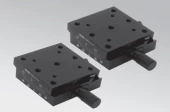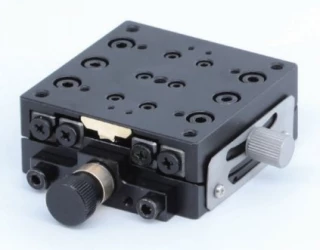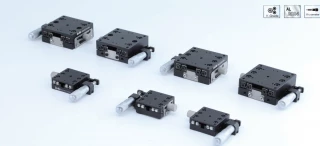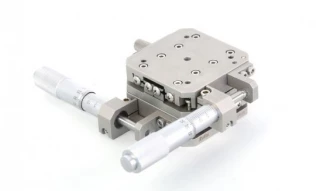Description
Zolix Instruments' TSMG 10-1/2W Manual goniometers are made of aluminum alloy with a big table size of 65×65 mm. The travel range is up to 10°. These goniometric stages are used for changing the sample yaw and pitch precisely. Generally, a goniometric stage rotates the object about an axis, which is unobstructed by the stage and is located over the center of the top platform.
TSMG Series Manual Goniometer
Specifications
| Travel Range: | -10 – 10 deg |
|---|---|
| Center Of Rotation: | 76 mm |
| Load Capacity (horizontal): | 2 kg |
| Load Capacity (vertical): | Not Specified |
| Table Size: | 65 mm |
Features
TSMG series goniometric stages exhibit the following features:
- +/-10 degree angular adjustment range
- Center height from 76 to 100 mm
- Black anodized aluminum material
Applications
Our goniometric stages are used in object and laser beam pointing control applications in a number of fields, such as material processing, spectroscopy, tracking, etc.
Frequently Asked Questions
What is a goniometer?
A goniometer is an instrument that measures an angle or allows an object to be precisely rotated to certain angular position.
What are goniometric stages made of?
Typically, goniometric stages are made of aluminum with or without black anodization, or stainless steel.
How much rotation do goniometer stages normally provide?
±10° of rotation is typical for most goniometer stages for scientific and industrial applications.
Are manual and motorized drives interchangeable?
They can be interchangeable depending on the model and the manufacturer.
How do I ensure the angular position is secured in my setup to avoid misalignment or stage walk?
Most goniometric stages come with a locking mechanism which allows securing the angular position. Check the details in manufacturer's specifications before making your purchase.
Can I stack goniometric stages to get multi-dimensional angular adjustment control?
Yes, goniometers can be stacked up. However, for best results it's recommended to stack goniometers from the same supplier.
What is the load capacity of typical goniometer stages?
Typical load capacity is in 1 to 3 kg range but it can be higher, depending on the model.
What is the price range of goniometer stages?
The price range in rather broad, from under $100 to over $2,000, depending on the material, stiffness, angular range, actuator resolution, backlash spec, load capacity and country of manufacture.
What is the table size of the TSMG Series Manual Goniometer?
The table size of the TSMG Series Manual Goniometer is 65×65 mm.
What is the travel range of the TSMG Series Manual Goniometer?
The travel range of the TSMG Series Manual Goniometer is up to 10°.
What are the features of the TSMG Series Manual Goniometer?
The TSMG Series Manual Goniometer features a +/-10 degree angular adjustment range and a center height from 76 to 100 mm. It is made of black anodized aluminum material.
What are the applications of the TSMG Series Manual Goniometer?
The TSMG Series Manual Goniometer is used in object and laser beam pointing control applications in fields such as material processing, spectroscopy, and tracking.
What are the naming rules for the TSMG Series Manual Goniometer?
The naming rules for the TSMG Series Manual Goniometer are as follows: TSMG + Travel Range + Center Height + Dimension Position. For example, TSMG10-1W represents a goniometer with a travel range of ±10°, a center height of 100 mm, and a dimension position of bottom.
Similar Products
Thank You!
Your inquiry has been received.
Create an account by adding a password
Why create an account?
- Auto-complete inquiry forms
- View and manage all your past messages
- Save products to your favorites
- Close your account anytime — no hassle



